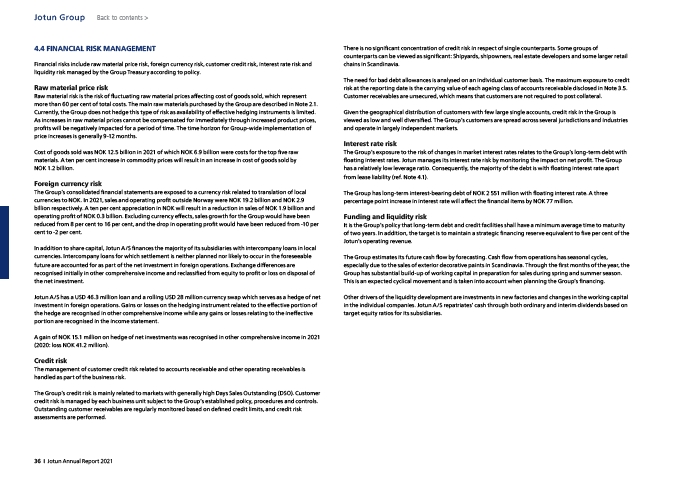
Back to contents >
4.4 FINANCIAL RISK MANAGEMENT
Financial risks include raw material price risk, foreign currency risk, customer credit risk, interest rate risk and
liquidity risk managed by the Group Treasury according to policy.
Raw material price risk
Raw material risk is the risk of fluctuating raw material prices affecting cost of goods sold, which represent
more than 60 per cent of total costs. The main raw materials purchased by the Group are described in Note 2.1.
Currently, the Group does not hedge this type of risk as availability of effective hedging instruments is limited.
As increases in raw material prices cannot be compensated for immediately through increased product prices,
profits will be negatively impacted for a period of time. The time horizon for Group-wide implementation of
price increases is generally 9-12 months.
Cost of goods sold was NOK 12.5 billion in 2021 of which NOK 6.9 billion were costs for the top five raw
materials. A ten per cent increase in commodity prices will result in an increase in cost of goods sold by
NOK 1.2 billion.
Foreign currency risk
The Group’s consolidated financial statements are exposed to a currency risk related to translation of local
currencies to NOK. In 2021, sales and operating profit outside Norway were NOK 19.2 billion and NOK 2.9
billion respectively. A ten per cent appreciation in NOK will result in a reduction in sales of NOK 1.9 billion and
operating profit of NOK 0.3 billion. Excluding currency effects, sales growth for the Group would have been
reduced from 8 per cent to 16 per cent, and the drop in operating profit would have been reduced from -10 per
cent to -2 per cent.
In addition to share capital, Jotun A/S finances the majority of its subsidiaries with intercompany loans in local
currencies. Intercompany loans for which settlement is neither planned nor likely to occur in the foreseeable
future are accounted for as part of the net investment in foreign operations. Exchange differences are
recognised initially in other comprehensive income and reclassified from equity to profit or loss on disposal of
the net investment.
Jotun A/S has a USD 46.3 million loan and a rolling USD 28 million currency swap which serves as a hedge of net
investment in foreign operations. Gains or losses on the hedging instrument related to the effective portion of
the hedge are recognised in other comprehensive income while any gains or losses relating to the ineffective
portion are recognised in the income statement.
A gain of NOK 15.1 million on hedge of net investments was recognised in other comprehensive income in 2021
(2020: loss NOK 41.2 million).
Credit risk
The management of customer credit risk related to accounts receivable and other operating receivables is
handled as part of the business risk.
The Group’s credit risk is mainly related to markets with generally high Days Sales Outstanding (DSO). Customer
credit risk is managed by each business unit subject to the Group’s established policy, procedures and controls.
Outstanding customer receivables are regularly monitored based on defined credit limits, and credit risk
assessments are performed.
There is no significant concentration of credit risk in respect of single counterparts. Some groups of
counterparts can be viewed as significant: Shipyards, shipowners, real estate developers and some larger retail
chains in Scandinavia.
The need for bad debt allowances is analysed on an individual customer basis. The maximum exposure to credit
risk at the reporting date is the carrying value of each ageing class of accounts receivable disclosed in Note 3.5.
Customer receivables are unsecured, which means that customers are not required to post collateral.
Given the geographical distribution of customers with few large single accounts, credit risk in the Group is
viewed as low and well diversified. The Group’s customers are spread across several jurisdictions and industries
and operate in largely independent markets.
Interest rate risk
The Group’s exposure to the risk of changes in market interest rates relates to the Group’s long-term debt with
floating interest rates. Jotun manages its interest rate risk by monitoring the impact on net profit. The Group
has a relatively low leverage ratio. Consequently, the majority of the debt is with floating interest rate apart
from lease liability (ref. Note 4.1).
The Group has long-term interest-bearing debt of NOK 2 551 million with floating interest rate. A three
percentage point increase in interest rate will affect the financial items by NOK 77 million.
Funding and liquidity risk
It is the Group’s policy that long-term debt and credit facilities shall have a minimum average time to maturity
of two years. In addition, the target is to maintain a strategic financing reserve equivalent to five per cent of the
Jotun’s operating revenue.
The Group estimates its future cash flow by forecasting. Cash flow from operations has seasonal cycles,
especially due to the sales of exterior decorative paints in Scandinavia. Through the first months of the year, the
Group has substantial build-up of working capital in preparation for sales during spring and summer season.
This is an expected cyclical movement and is taken into account when planning the Group’s financing.
Other drivers of the liquidity development are investments in new factories and changes in the working capital
in the individual companies. Jotun A/S repatriates’ cash through both ordinary and interim dividends based on
target equity ratios for its subsidiaries.
Jotun Group
36 I Jotun Annual Report 2021